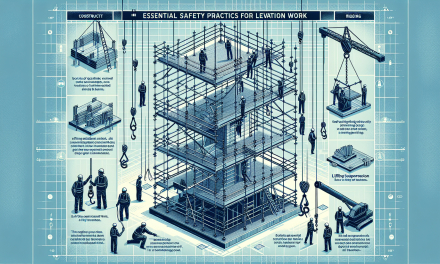Table of Contents
- Introduction
- The Importance of Advanced Health and Safety Management
- What to Expect from Advanced Health and Safety Management Learning
- Key Topics Covered
- Who Should Participate?
- Benefits of Advanced Health and Safety Management
- Additional Resources
- FAQs
- Conclusion
Introduction
In today’s ever-evolving workplace, prioritizing health and safety has become more important than ever. Organizations are recognizing that a proactive approach to implementing health and safety practices not only protects employees but also enhances productivity and company reputation.
Through comprehensive training in health and safety management, leaders empower themselves to navigate the complexities of creating a safe working environment. This training offers essential insights and practical tools necessary for shaping a safety-first culture.
The Importance of Advanced Health and Safety Management
Ultimately, the goal of managing health and safety in the workplace centers on prevention. The focus shifts from merely complying with regulations to proactively fostering a culture of safety. Moreover, effective health and safety management significantly reduces liability risks and enhances overall organizational performance.
Additionally, investing in advanced management approaches helps organizations to:
- Lower accident rates
- Enhance employee morale and job satisfaction
- Improve compliance with legal standards
- Boost productivity and efficiency
- Enhance organizational reputation
What to Expect from Advanced Health and Safety Management Learning
Participants in advanced training programs delve into a series of immersive sessions that blend theoretical knowledge with practical exercises. Engaging workshops and interactive discussions offer invaluable insights into intricate safety challenges, enabling learners to re-evaluate and strengthen existing safety protocols.
Interactive Learning Environment
The learning environment fosters collaboration among peers, encouraging participants to share experiences and solutions. By discussing real-life case studies, individuals gain unique perspectives and solutions to common health and safety challenges.
Expert Instructors
Learning from seasoned health and safety professionals ensures that attendees receive guidance from those who truly understand best practices in the field. With their experience, leaders can better appreciate nuanced topics such as risk assessment, emergency preparedness, and regulatory compliance.
Key Topics Covered
Advanced training encompasses a wide range of critical topics, allowing professionals to develop a broad understanding of health and safety management.
Risk Assessment and Management
Risk assessment remains a cornerstone of any effective health and safety program. By learning how to identify potential hazards and assess risks, participants can develop strategies to mitigate those risks before they result in incidents.
Legal Compliance
Understanding local and national regulations surrounding workplace safety is crucial. This knowledge equips professionals to ensure that companies remain compliant and avoid costly penalties.
Emergency Preparedness and Response
Being prepared for emergencies can make all the difference during a crisis. Learning how to implement an effective emergency response plan, along with conducting drills, significantly enhances workplace safety.
Creating a Safety Culture
Promoting a culture of safety means instilling in every employee the importance of health and safety practices. This culture should encourage open communication about safety concerns, empowering workers to speak up about potential hazards.
Advanced Leadership Techniques
Leadership plays a vital role in health and safety management. By mastering advanced leadership techniques, participants will learn how to inspire and motivate teams towards prioritizing safety.
Who Should Participate?
Individuals in various roles can benefit significantly from advanced training in health and safety management. Specifically, those in the following positions should consider enrolling:
- Health and safety officers
- HR managers
- Operations managers
- Site supervisors
- Environmental health and safety professionals
- Anyone involved in decision-making relating to workplace safety
Benefits of Advanced Health and Safety Management
Enrolling in advanced training brings a plethora of benefits, not just for individuals but also for the organizations they represent:
Empowered Professionals
Participants finish training with the confidence and skills necessary to effectively handle various health and safety challenges. This empowerment translates into improved decision-making abilities on the job.
Enhanced Organizational Safety Performance
Organizations that invest in their workforce see direct improvements in safety performance. Reduced accidents and injuries equate to fewer insurance claims and associated costs.
Stronger Compliance
A well-informed team is a compliant team. With a comprehensive understanding of legal requirements, companies can avoid costly fines and penalties while creating a safer environment for everyone.
Networking Opportunities
Advanced training offers exceptional networking opportunities, allowing participants to connect with other professionals in the field. These relationships can lead to collaborative efforts and shared learning experiences.
Additional Resources
To further expand your knowledge on various health and safety topics, consider exploring the following resources:
- Mastering Alarm Management: Your Guide to Best Practices
- Essential Practices for Safe Elevation, Scaffolding, Rigging, and Lifting Supervision
- Mastering HAZOP Leadership: A Comprehensive Path to Process Hazard Analysis Expertise
- Eco-Safe Practices: A Comprehensive Guide to Contamination and Hazardous Waste Management Prevention
- Navigating Safety Technology and Risk Management
Among the various training options available, achieving an Advanced Health & Safety Management Course Certification can serve as a milestone in your professional journey.
FAQs
What are the prerequisites for participating in an advanced training program?
While formal prerequisites can vary, a foundational understanding of workplace health and safety practices is generally recommended. Participation is ideal for those already working in health and safety roles.
How long does it take to complete advanced health and safety management training?
The duration typically depends on the specific program structure. However, many advanced training options can be completed within a few days to a couple of weeks.
Is there a certification examination at the end of the training?
Typically, participants are required to complete an examination or project to assess their understanding and application of the material, leading to certification.
Conclusion
In conclusion, investing in advanced health and safety management training not only benefits individuals but also fosters a culture of safety that can significantly enhance workplace performance. Leaders gain the necessary skills and insights to navigate the complexities of health and safety management, ultimately ensuring the well-being of employees and the organization as a whole.
With the ever-increasing emphasis on workplace safety, equipping oneself with advanced knowledge and tools becomes essential. By prioritizing effective health and safety strategies today, professionals will contribute to creating a safer tomorrow. So, why wait? Start your journey towards excellence in health and safety management today!





